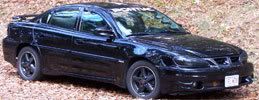That whole article is great. I am looking for more now, esp interested in the forced pin oiling....
Announcement
Collapse
No announcement yet.
Very interesting read from CP-Carillo
Collapse
X
-
I'm not sure forced pin oiling is required except on the most extreme engines. I recently bought a set of rods where pin oiling was an option. However, after doing some rod sizing math I determined that the pin end of the rod will see almost 8,000 g's. What that means is that any oil collecting in the oiling cups is essentially pressurized by the g loading acting on it.
The rod maker I purchased the rods from said very few people need the pin oiling holes. Apparently NASCAR doesn't run too many pin oiled rods.
If anyone finds any articles that specifically discuss the need based on dyno tests or broken parts I'd be interested to read them.
Comment
-
I have to agree. True innovation is dawned from necessity. If it doesn't break and someone offers a solution, it's about money. Doesn't mean the product isn't superior, more like putting forged pistons in a moped or lawn mower.Originally posted by NateD4 View PostI did, it doesn't tell me I need them. Also they offer other pin oiling problems. DLC coated pins help retain oil and on most applications conventional oiling has worked well enough. When was the last time you've seen failed wrist pins due to oil issues?1996 Grand Prix | 3100v6 L82 | T04E-50 Turbo | Getrag 282 w/ EP LSD | SPEC-3 Clutch
Comment
-
I'm surprised motor oil can withstand such conditions in these special wrist pin rods.....considering the amount of force and how it is an oscillating journal like bearing. I can imagine the oil film must be really thin to retain enough surface tension preventing it from being squished out.1996 Grand Prix | 3100v6 L82 | T04E-50 Turbo | Getrag 282 w/ EP LSD | SPEC-3 Clutch
Comment
-
The normal clearance on journal bearings is 0.001" per inch. Wrist pins typically run about .001". You have to keep in mind the loads aren't that high in terms of pressure relative to the oil's shear and load carrying capacity. Additionally the molecular forces are enough to coat parts.
Remember oils main function is to prevent galling due to metal to metal contact. A secondary function is cooling.
Most rods in production engines are splash oiled while some higher end rods have an oil cup where the acceleration of the rod pressurizes the oil that's collected during a revolution.
Comment
-
but then i would have the baldest ass lawn mower on the block and probably the one with the most expensive engine.Originally posted by TGP37 View PostI have to agree. True innovation is dawned from necessity. If it doesn't break and someone offers a solution, it's about money. Doesn't mean the product isn't superior, more like putting forged pistons in a moped or lawn mower.sigpic
99 Grand Am GT
3400/3500 -Solid trans mount--TCE 65mm T-body---85mm LS2 maf---1 1/4' TCE intake spacers with 3400 upper--SLP Catback with flowmaster 80--TOG headers
Modded 3400 lifters with LT1 springs---Comp Cams 26986 Springs
1357 cam 227 233 .050 dur 515 515 lift 112 lsa
15.232@88.85mph on stock 3400---New time to come
Comment
-
lol, speaking of forged piston mowers, you could have a small NOS and have it kick in if the RPM's fall below a point (stress) and continue to add power until RPM's stabilize. Should be able to mow through anything...ANYthing.Originally posted by geldartb View Postbut then i would have the baldest ass lawn mower on the block and probably the one with the most expensive engine.
Yeah, there is glory in building the finest. Now you got me thinking about the next short block I want to assemble, for insane boost.1996 Grand Prix | 3100v6 L82 | T04E-50 Turbo | Getrag 282 w/ EP LSD | SPEC-3 Clutch
Comment
-
If you are running an engine on .001 bearing clearances, that is wayyyy to tight. I have seen quite a few engines burn up from that alone.Originally posted by NateD4 View PostThe normal clearance on journal bearings is 0.001" per inch. Wrist pins typically run about .001". You have to keep in mind the loads aren't that high in terms of pressure relative to the oil's shear and load carrying capacity. Additionally the molecular forces are enough to coat parts.
Remember oils main function is to prevent galling due to metal to metal contact. A secondary function is cooling.
Most rods in production engines are splash oiled while some higher end rods have an oil cup where the acceleration of the rod pressurizes the oil that's collected during a revolution.
Comment
-
The tolerance depends on viscosity also. A 0W oil can run tighter tolerances.
My post said 0.001" per inch diameter as a general rule of thumb. Which puts a stock engine 2.000" rod journal at about .002" and wrist pin at about .001" for a .8-.9" dia pin. That probably sounds better??
Comment



Comment